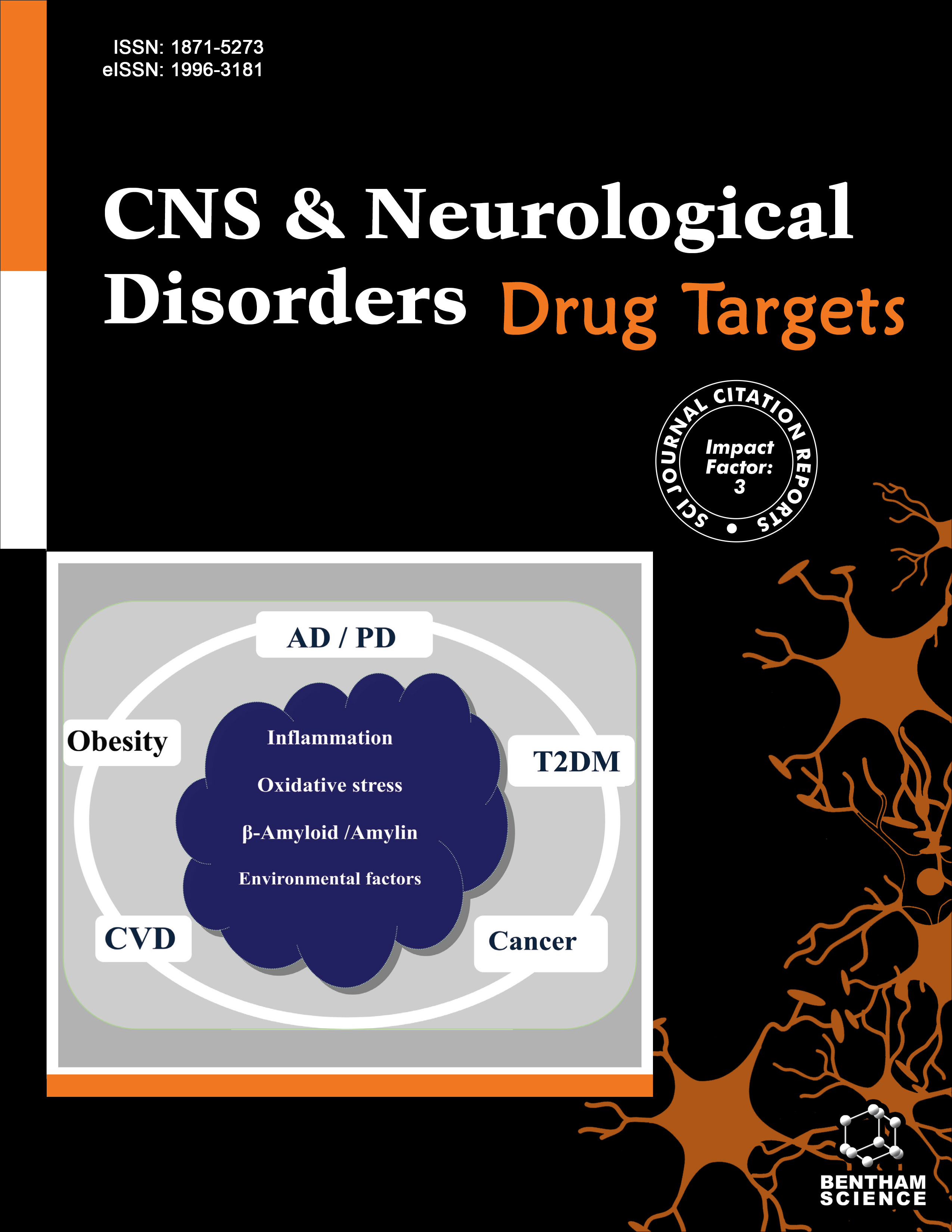- Home
- A-Z Publications
- CNS & Neurological Disorders - Drug Targets (Formerly Current Drug Targets - CNS & Neurological Disorders)
- Previous Issues
- Volume 18, Issue 9, 2019
CNS & Neurological Disorders - Drug Targets (Formerly Current Drug Targets - CNS & Neurological Disorders) - Volume 18, Issue 9, 2019
Volume 18, Issue 9, 2019
-
-
The Structure and Function of α, β and γ-Secretase as Therapeutic Target Enzymes in the Development of Alzheimer’s Disease: A Review
More LessAuthors: Syed S. Ahmad, Shahzad Khan, Mohammad A. Kamal and Umam WasiAlzheimer's disease is a progressive neurodegenerative disorder that affects the central nervous system. There are several factors that cause AD, like, intracellular hyperphosphorylated Tau tangles, collection of extracellular Amyloid-β42 and generation of reactive oxygen species due to mitochondrial dysfunction. This review analyses the most active target of AD and both types of AD-like early-onset AD and late-onset AD Read More
-
-
-
Dantrolene : From Malignant Hyperthermia to Alzheimer’s Disease
More LessAuthors: Yun Shi, Yong Wang and Huafeng WeiDantrolene, a ryanodine receptor antagonist, is primarily known as the only clinically acceptable and effective treatment for Malignant Hyperthermia (MH). Inhibition of Ryanodine Receptor (RyR) by dantrolene decreases the abnormal calcium release from the Sarcoplasmic Reticulum (SR) or Endoplasmic Reticulum (ER), where RyR is located. Recently, emerging researches on dissociated cells, brains slices, li Read More
-
-
-
Childhood Hypertension and Effects on Cognitive Functions: Mechanisms and Future Perspectives
More LessAuthors: Emma Tyner, Marie Oropeza, Johnny Figueroa and Ike C. dela PeñaPediatric hypertension is currently one of the most common health concerns in children, given its effects not only on cardiovascular but also cognitive functions. There is accumulating evidence suggesting neurocognitive dysfunction in hypertensive children that could persist even into adulthood. Identifying the precise mechanism(s) underlying the association between childhood hypertension and cognitive dysfunction is Read More
-
-
-
Gut Microbiome: Lactation, Childbirth, Lung Dysbiosis, Animal Modeling, Stem Cell Treatment, and CNS Disorders
More LessHere, we summarized recent advances in laboratory and clinical research on gut microbiome. The goal is to highlight recent discoveries on the biology and behavioral manifestations of gut microbiomes under normal and pathologic conditions. With this new scientific knowledge, we wish to cultivate cross-fertilization of science across multi-disciplines in the hopes of exploiting the gut microbiome as a key component of huma Read More
-
-
-
Carvedilol Promotes Retinal Ganglion Cell Survival Following Optic Nerve Injury via ASK1-p38 MAPK Pathway
More LessAuthors: Bei Liu and Yu-Jia LiuBackground: Carvedilol, which is considered as a nonselective β-adrenoreceptor blocker, has many pleiotropic activities. It also causes great impact on neuroprotection because of its antioxidant ability, which suggested that carvedilol may be effective in protecting RGCs from increased oxidative stress. Objective: To examine the effects of carvedilol on preventing Retinal Ganglion Cell (RGC) death in a mouse model of Optic Nerve I Read More
-
-
-
Cannabidiol Partially Blocks the Excessive Sleepiness in Hypocretin-deficient Rats: Preliminary Data
More LessBackground: Excessive daytime sleepiness and cataplexy are among the symptoms of narcolepsy, a sleep disorder caused by the loss of hypocretin/orexin (HCRT/OX) neurons placed into the Hypothalamus (LH). Several treatments for managing narcolepsy include diverse drugs to induce alertness, such as antidepressants, amphetamine, or modafinil, etc. Recent evidence has shown that cannabidiol (CBD), a non-ps Read More
-
-
-
Combined Ischemic Preconditioning and Resveratrol Improved Blood-brain Barrier Breakdown via Hippo/YAP/TAZ Signaling Pathway
More LessAuthors: Ganji Hong, Ying Yan, Yali Zhong, Jianer Chen, Fei Tong and Qilin MaBackground: Transient Ischemia/Reperfusion (I/R) is the main reason for brain injury and results in disruption of the Blood-Brain Barrier (BBB). It had been reported that BBB injury is one of the main risk factors for early death in patients with cerebral ischemia. Numerous investigations focus on the study of BBB injury which have been carried out. Objective: The objective of this study was to investigate the treatment function of t Read More
-
-
-
The Potential of Serratiopetidase and Lumbrokinase for the Degradation of Prion Peptide 106-126 - an In Vitro and In Silico Perspective
More LessAuthors: Sanjay K. Metkar, Suparna Ghosh, Agnishwar Girigoswami and Koyeli GirigoswamiBackground: PrPC is a host-encoded prion protein, which gets post translationally modified into a transmissible, β-sheet rich disease associated protein called PrPSc, responsible for the Prion disease including mad cow disease in cattle and CJD in humans. The PrP 106-126 region in PrPSc peptide initiates the conformational change in that protein leading to fibrillation. Any agent that can destabilize or disintegrate such prot Read More
-
Volumes & issues
-
Volume 24 (2025)
-
Volume 23 (2024)
-
Volume 22 (2023)
-
Volume 21 (2022)
-
Volume 20 (2021)
-
Volume 19 (2020)
-
Volume 18 (2019)
-
Volume 17 (2018)
-
Volume 16 (2017)
-
Volume 15 (2016)
-
Volume 14 (2015)
-
Volume 13 (2014)
-
Volume 12 (2013)
-
Volume 11 (2012)
-
Volume 10 (2011)
-
Volume 9 (2010)
-
Volume 8 (2009)
-
Volume 7 (2008)
-
Volume 6 (2007)
-
Volume 5 (2006)
Most Read This Month
Article
content/journals/cnsnddt
Journal
10
5
false
en

Most Cited Most Cited RSS feed
-
-
A Retrospective, Multi-Center Cohort Study Evaluating the Severity- Related Effects of Cerebrolysin Treatment on Clinical Outcomes in Traumatic Brain Injury
Authors: Dafin F. Muresanu, Alexandru V. Ciurea, Radu M. Gorgan, Eva Gheorghita, Stefan I. Florian, Horatiu Stan, Alin Blaga, Nicolai Ianovici, Stefan M. Iencean, Dana Turliuc, Horia B. Davidescu, Cornel Mihalache, Felix M. Brehar, Anca . S. Mihaescu, Dinu C. Mardare, Aurelian Anghelescu, Carmen Chiparus, Magdalena Lapadat, Viorel Pruna, Dumitru Mohan, Constantin Costea, Daniel Costea, Claudiu Palade, Narcisa Bucur, Jesus Figueroa and Anton Alvarez
-
-
-
- More Less

